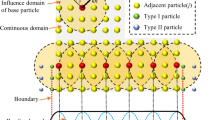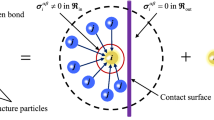Abstract
A hydraulic–mechanical coupling model based on smooth particle dynamics (HM-SPD) is proposed to simulate the seepage failure process of rocks. In the SPD program, the damage particles determined by the Mohr–Coulomb criterion are captured to dynamically track the fracture behavior of the rock, such as the initiation, propagation and penetration of cracks. Firstly, the accuracy of smooth particle dynamics (SPD) seepage theory is verified by a one-dimensional transient seepage example, and the numerical results agree well with the analytical solution. Then, the robustness and accuracy of the HM-SPD coupling model are verified by a biaxial compression experiment. The numerical results agree well with those of RFPA. In addition, the effects of positioning parameters, homogeneity index and confining pressure on rock fracture are also studied. Numerical results show that with the increase in positioning parameters, homogeneity index and confining pressure, the peak strength and peak strain of the sample gradually increase.














Similar content being viewed by others
References
Ajayi K, Shahbazi K, Tukkaraja P, Katzenstein K (2019) Numerical investigation of the effectiveness of radon control measures in cave mines. Int J Min Sci Technol 29(3):469–475
Belytschko T, Black T (1999) Elastic crack growth in finite elements with minimal remeshing. Int J Numer Methods Eng 45:601–620
Belytschko T, Guo Y, Liu WK, Xiao SP (2000) A unified stability analysis of meshless particle methods. Int J Numer Methods Eng 48:1359–1400
Benz W, Asphaug E (1995) Simulations of brittle solids using smooth particle hydrodynamics. Comput Phys Commun 87:253–265
Bi J, Zhou XP (2017) A novel numerical algorithm for simulation of initiation, propagation and coalescence of flaws subject to internal fluid pressure and vertical stress in the framework of general particle dynamics. Rock Mech Rock Eng 50:1833–1849
Biot MA (1941) General theory of three-dimensional consolidation. J Appl Phys 12:155–164
Bouchard PO, Baya F, Chastela Y, Tovena I (2000) Crack propagation modelling using an advanced remeshing technique. Comput Methods Appl Mech Eng 189:723–742
Branco R, Antunes F, Costa J (2015) A review on 3D-FE adaptive remeshing techniques for crack growth modelling. Eng Fract Mech 141:170–195
Chakraborty S, Shaw A (2013) A pseudo-spring based fracture model for SPH simulation of impact dynamics. Int J Impact Eng 58:84–95
Cheng H, Zhou XP (2015) A multi-dimensional space method for dynamic cracks problems using implicit time scheme in the framework of the extended finite element method. Int J Damage Mech 24(6):859–890
Clear PW, Monaghan JJ (1999) Conducting modeling using smoothed particle hydrodynamics. J Comput Phys 148(1):227–264
Cundall PA, Strack ODL (1979) A discrete numerical model for granular assemblies. Geotechnique 29(1):47–65
Fang Z, Harrison JP (2002a) Application of a local degradation model to the analysis of brittle fracture of laboratory scale rock specimens under triaxial conditions. Int J Rock Mech Min 39(4):459–476
Fang Z, Harrison JP (2002b) Development of a local degradation approach to the modeling of brittle fracture inheterogeneous rocks. Int J Rock Mech Min 39(4):443–457
Gingold RA, Monaghan JJ (1977) Smoothed particle hydrodynamics: theory and application to non-spherical stars. Mon Not R Astron Soc 181:375–389
Hadjigeorgiou J, Esmaieli K, Grenon M (2009) Stability analysis of vertical excavations in hard rock by integrating a fracture system into a PFC model. Tunn Undergr Sp Tech 24(3):296–308
Kong XY (2010) Advanced seepage mechanics. University of Science of China Press, Hefei
Li X, Wang S, Ge S (2018) A study on drum cutting properties with full-scale experiments and numerical simulations. Measurement 114:25–36
Liang ZZ, Xing H, Wang SY, Williams DJ, Tang CA (2012) A three-dimensional numerical investigation of the fracture of rock specimens containing a pre-existing surface flaw. Comput Geotech 45:19–33
Libersky LD, Petschek AG, Carney TC, Hipp JR, Allahdadi FA (1993) High strain lagrangian hydrodynamics: a three-dimensional SPH code for dynamic material response. J Comput Phys 109(1):67–75
Lucy LB (1977) A numerical approach to testing the fission hypothesis. Astron J 82:1013–1024
Moes N, Dolbow J, Belyschko T (1999) A finite element method for crack growth without remeshing. Int J Numer Methods Eng 46:131–150
Monaghan JJ (1992) Smoothed particle hydrodynamics. Annu Rev Astron Astrophys 30:543–574
Monaghan JJ (1994) Simulating free surface flows with SPH. J Comput Phys 110(2):399–406
Monaghan JJ, Gingold RA (1983) Shock simulation by the particle method SPH. J Comput Phys 52:374–389
Ning YJ, An XM, Ma GW (2011) Footwall slope stability analysis with the numerical manifold method. Int J Rock Mech Min Sci 48:964–975
Paluszny A, Matthai SK (2009) Numerical modeling of discrete multi-crack growth applied to pattern formation in geological brittle media. Int J Solids Struct 46:3383–3397
Rannou J, Limodin N, Réthoré J, Gravouil A, Ludwig W, Baïetto-Dubourg MC et al (2010) Three dimensional experimental and numerical multiscale analysis of a fatigue crack. Comput Meth Appl Mech 199:1307–1325
Shaw A, Reid SR (2009) Heuristic acceleration correction algorithm for use in SPH computations in impact mechanics. Comput Methods Appl Mech Eng 198(49–52):3962–3974
Shaw A, Roy D, Reid SR (2011) Optimised form of acceleration correction algorithm within SPH-based simulations of impact mechanics. Int J Solids Struct 48(25–26):3484–3498
Shi GH, Goodman RE (1989) Generalization of two-dimensional discontinuous deformation analysis for forward modeling. Int J Numer Anal Met 13:359–380
Silling SA (2000) Reformulation of elasticity theory for discontinuities and long-range forces. J Mech Phys Solids 48(1):175–209
Silling SA, Askari E (2005) A meshfree method based on the peridynamic model of solid mechanics. Comput Struct 83:1526–1535
Silling SA, Lehoucq RB (2010) Peridynamic theory of solid mechanics. Adv Appl Mech 44:73–168
Song J, Chen F, Wang F (2015) Study on the characteristics of the fracture process zone in concrete crack propagation based on FRANC3D. Int J Earth Sci Eng 8(2):849–853
Sun PN (2018) Study on SPH method for the simulation of object-free surface interactions. Harbin Engineering University, Harbin
Takeda H, Miyama SM, Sekiya M (1994) Numerical simulation of viscous flow by smoothed particle hydrodynamics. Prog Theor Phys 92(5):939–960
Tang C, Li L, Li W, Ma T (2006) RFPA strength reduction method for stability analysis of geotechnical engineering. Chin J Rock Mech Eng 15(8):1522–1530
Tian J, Xu D, Liu T (2020) An experimental investigation of the fracturing behaviour of rock-like materials containing two V-shaped parallelogram flaws. Int J Min Sci Technol 30(6):777–783
Tsay RJ, Chiou YJ, Chuang WL (1999) Crack growth prediction by manifold method. J Eng Mech 125:884–890
Wong LNY, Wu ZJ (2014) Application of the numerical manifold method to model progressive failure in rock slopes. Eng Fract Mech 119:1–20
Wu ZJ, Wong LNY (2012) Frictional crack initiation and propagation analysis using the numerical manifold method. Comput Geotech 39:38–53
Xie Y, Cao P, Liu J, Dong L (2016) Influence of crack surface friction on crack initiation and propagation: a numerical investigation based on extended finite element method. Comput Geotech 74:1–14
Xu XY, Deng XL (2016) An improved weakly compressible SPH method for simulating free surface flows of viscous and viscoelastic fluids. Comput Phys Commun 201:43–62
Xu X, Needleman A (1994) Numerical simulations of fast crack growth in brittle solids. J Mech Phys Solids 42(9):1397–1434
Yang TH (2001) Study on infiltrate character and coupling analysis of seepage and stress in rock failure process. Northeastern University, Shenyang
Yang S, Cao M, Ren X (2018) 3D crack propagation by the numerical manifold method. Comput Struct 194(1):116–129
Yu SY, Ren XH, Wang HJ, Zhang JX, Sun ZH (2021a) Numerical simulation on the interaction modes between hydraulic and natural fractures based on a new SPH method. Arab J Sci Eng. https://doi.org/10.1007/s13369-021-05672-x
Yu SY, Ren XH, Zhang JX, Wang HJ, Sun ZH (2021b) An improved form of smoothed particle hydrodynamics method for crack propagation simulation applied in rock mechanics. Int J Min Sci Technol 31:421–428
Zhang GX, Zhao Y, Peng XC (2010a) Simulation of topping failure of rock slope by numerical manifold method. Int J Comput Meth 7:167–189
Zhang HH, Li LX, An XM, Ma GW (2010b) Numerical analysis of 2-D crack propagation problems using the numerical manifold method. Eng Anal Bound Elem 34:41–50
Zhao Z (2013) Gouge particle evolution in a rock fracture undergoing shear: a microscopic DEM study. Rock Mech Rock Eng 46(6):1461–1479
Zhao Z, Jing L, Neretnieks I (2012) Particle mechanics model for the effects of shear on solute retardation coefficient in rock fractures. Int J Rock Mech Min 52(6):92–102
Zhou XP, Shou YD (2017) Numerical simulation of failure of rock-like material subjected to compressive loads using improved peridynamic method. Int J Geomech 17(3):04016086
Zhou J, Lan H, Zhang L (2019) Novel grain-based model for simulation of brittle failure of Alxa porphyritic granite. Eng Geol 251:100–114
Acknowledgments
This study was supported by National Key Research and Development Plan Project (2018YFC0809605). The financial support is greatly appreciated.
Author information
Authors and Affiliations
Corresponding author
Ethics declarations
Conflict of interest
The authors declare that they have no known competing financial interests or personal relationships that could have appeared to influence the work reported in this paper.
Additional information
Responsible Editor: Zeynal Abiddin Erguler
Rights and permissions
About this article
Cite this article
Mu, D., Tang, A. & Huang, D. A hydraulic–mechanical coupling model based on smoothed particle dynamics for simulating rock fracture. Arab J Geosci 15, 485 (2022). https://doi.org/10.1007/s12517-022-09493-6
Received:
Accepted:
Published:
DOI: https://doi.org/10.1007/s12517-022-09493-6




